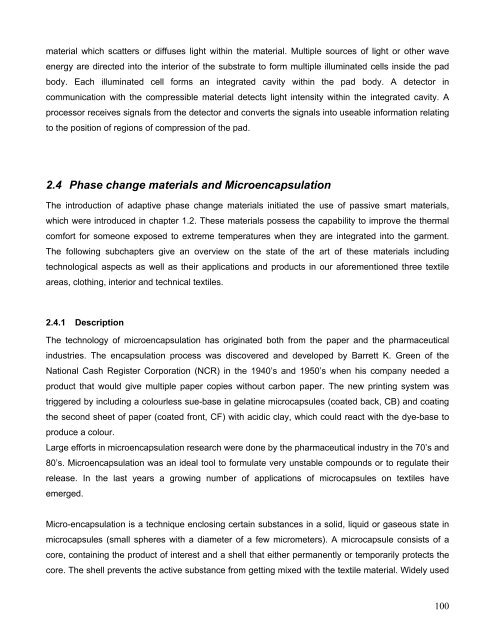Clevertex - Grado Zero Espace Srl
Clevertex - Grado Zero Espace Srl
Clevertex - Grado Zero Espace Srl
You also want an ePaper? Increase the reach of your titles
YUMPU automatically turns print PDFs into web optimized ePapers that Google loves.
material which scatters or diffuses light within the material. Multiple sources of light or other wave<br />
energy are directed into the interior of the substrate to form multiple illuminated cells inside the pad<br />
body. Each illuminated cell forms an integrated cavity within the pad body. A detector in<br />
communication with the compressible material detects light intensity within the integrated cavity. A<br />
processor receives signals from the detector and converts the signals into useable information relating<br />
to the position of regions of compression of the pad.<br />
2.4 Phase change materials and Microencapsulation<br />
The introduction of adaptive phase change materials initiated the use of passive smart materials,<br />
which were introduced in chapter 1.2. These materials possess the capability to improve the thermal<br />
comfort for someone exposed to extreme temperatures when they are integrated into the garment.<br />
The following subchapters give an overview on the state of the art of these materials including<br />
technological aspects as well as their applications and products in our aforementioned three textile<br />
areas, clothing, interior and technical textiles.<br />
2.4.1 Description<br />
The technology of microencapsulation has originated both from the paper and the pharmaceutical<br />
industries. The encapsulation process was discovered and developed by Barrett K. Green of the<br />
National Cash Register Corporation (NCR) in the 1940’s and 1950’s when his company needed a<br />
product that would give multiple paper copies without carbon paper. The new printing system was<br />
triggered by including a colourless sue-base in gelatine microcapsules (coated back, CB) and coating<br />
the second sheet of paper (coated front, CF) with acidic clay, which could react with the dye-base to<br />
produce a colour.<br />
Large efforts in microencapsulation research were done by the pharmaceutical industry in the 70’s and<br />
80’s. Microencapsulation was an ideal tool to formulate very unstable compounds or to regulate their<br />
release. In the last years a growing number of applications of microcapsules on textiles have<br />
emerged.<br />
Micro-encapsulation is a technique enclosing certain substances in a solid, liquid or gaseous state in<br />
microcapsules (small spheres with a diameter of a few micrometers). A microcapsule consists of a<br />
core, containing the product of interest and a shell that either permanently or temporarily protects the<br />
core. The shell prevents the active substance from getting mixed with the textile material. Widely used<br />
100

















